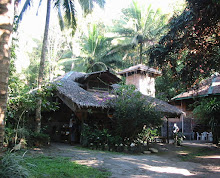Un hermoso Santiago de antaño.
You can see that Manila under the Americans was not such a big deal.
Veran que Manila bajo EEUU no era gran cosa.
This was the urban space created by the Liberal and Conservative elites that sought to duplicate Europe. Of course there were ugly spaces, without drinking water and sewage treatment, or electricity, in the popular areas of Santiago. But I am talking about the imaginary, and how there was investment in public infrastructure and an ethos of beauty.
Se trata del espacio urbano y público creado por la élite Liberal que reproducía Europa. Por supuesto que había espacios feos, sin agua potable, alcantarillado y recolección de desechos, sin electricidad, en las áreas populares de Santiago. Pero hablo del imaginario, cómo había inversión en infraestructura pública y un ethos de belleza.
The palaces ("Palacio") were PRIVATE RESIDENCES. Amazing wealth from agriculture, nitrate mining, shipping, gold mining etc.
Los palacios eran RESIDENCIAS PARTICULARES. Una riqueza increíble de la agricultura, la minería de salitre, oro, la industria naviera, etc.
Eso sí, había críticas de algunos palacios porque eran copias de palacios europeos pero COPIAS BARATAS. Por ejemplo, las columnas no eran de mármol sino de yeso. Si uno empujaba un poco, se rompían.
However, there were some criticisms of some palaces because they were CHEAP COPIES of European palaces. For example, the columns were not made of marble but of plaster. If you pushed your fist against them, they would break.
Esto era la característica de la estética de los nuevos ricos de la ex colonia española: proyectar LAS APARIENCIAS SIN VERDADERA SUBSTANCIA. Crear una impresión, proyectar una imagen, pero sin la base de auténtica cultura, porque la cultura mestiza era basicamente la copia de lo que se suponía superior, y la mayor ambición de estos ricos era ingresar a la realeza europea.
And this was the characteristic of the aesthetics of the new rich of the former Spanish colony: APPEARANCES WITHOUT REAL SUBSTANCE. To impress, to project an image, but the hard culture was missing, because mestizo culture was basically just a copy of what was believed superior, and the highest ambition of the rich was to marry into European royalty.
Los españoles en Filipinas estaban acostumbrados a este tipo de arquitectura y estética y encontraron el ambiente muy primitivo, a pesar de que el entorno era totalmente distinto y esos edificios pesados, encerrados, no estaban en absoluto apropiados para el terreno, el clima, el estilo de vida de la población nativa.
The Spanish in Filipinas who were used to this type of architecture and aesthetique found the tropical scenario very primitive, even if it was a totally different environment and these kinds of buildings were not at all suited to the land, the climate, the way of life of the native inhabitants.
Entonces en Intramuros, el casco antiguo de Manila, los españoles reprodujeron este tipo de mundo, con edificios señoriales y casas al estilo español (al principio no, esto pasó después del primer siglo, más-menos).
And so in Intramuros, the old Walled City of Manila, the Spanish reproduced this type of world, with imposing buildings and mansions in the Spanish style (not at the beginning, but after the first century more-or-less).
En general, los españoles consideraron todo lo que era nativo como inferior a su mundo.
In general, the Spanish considered everything native as inferior to their world.
Esto no solo sucedió en Filipinas, sino en todos los lugares donde los españoles fundaron sociedades coloniales.
This did not just happen in Filipinas, it happened everywhere the Spanish created their colonial societies.
Pero en lugares como México y Perú los españoles no pudieron hacer desaparecer de la conciencia indígena, el mundo pre-hispánico, la identidad indígena pre-hispánica sobrevivió.
But in places like Mexico and Peru, the Spanish were unable to disappear completely, to wipe out from the Indian consciousness, the pre-Hispanic world, and the pre-Hispanic Indian identity survived.
En Filipinas, los nativos filipinos _especialmente de las planicies de Luzón y Visayas_ se convirtieron en vasallos culturales y espirituales de los españoles.
In Filipinas, the native Filipinos _especially of the plains of Luzon and Visayas_ became the cultural and spiritual vassals of the Spanish.
Esto se debió a que los reyezuelos de los habitantes nativos de las islas aceptaron superponer la religiosidad cristiana y el polis griego sobre la organización social y religiosa nativas. Y esto significó mantener solo las relaciones sociales y productivas que servían a la nueva organización de la sociedad colonial, que era el paradigma aplicado por los españoles en todas sus colonias en el Caribe y las Américas.
This was due to the fact that the petty rulers of the native inhabitants of the islands agreed to superimpose Christian religiousness and the concept of the Greek polis over the native social and religious organization. And this meant maintaining only the social and productive relations that were useful to the new organization of the colonial society, which was the paradigm applied by the Spanish to all their colonies in the Caribbean and the Americas.
El polis griego era un nucleo, el área urbana central que controlaba las áreas rurales circundantes.
The Greek polis was a nucleus, the central urban area that controlled the surrounding countryside.








No comments:
Post a Comment